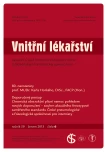Adherence and persistence with a focus on the treatment of hypertensive patients
Authors:
M. Souček
Authors‘ workplace:
II. interní klinika Lékařské fakulty MU a FN u sv. Anny v Brně, přednosta prof. MU Dr. Miroslav Souček, CSc.
Published in:
Vnitř Lék 2013; 59(6): 482-485
Category:
80th birthday prof. MUDr. Karla Horkého, DrSc., FACP (Hon.)
Overview
Insufficient adherence of patients to treatment is a serious problem and it is monitored most frequently in hypertensive patients. The possibilities of increasing adherence to long‑term treatment include mainly the motivation and education of patients, simple dosage regimes, telephone consultations and involving the patient in the treatment process (self‑ monitoring), but it also means provi-ding information about the consequences of failure to adhere to the treatment process. Other possibilities can include new dosage forms which increase the biological availability of medicines, reduce the variability of absorption, and thus allow for achieving their more stable levels. It is possible to take advantage of fixed combinations which can improve adherence. Some new dosage forms simplify the therapy for patients and make it more pleasant. One of the latest innovations is for example, orodispersible dosage forms, which have been recently introduced in the therapy of arterial hypertension. In order to improve the adherence of patients to hypertension treatment it is necessary to use all means available adjusted to the individual needs of patients.
Key words:
adherence – persistence – hypertension – orodispersible tablets
Sources
1. Vrablík M. Adherence k léčbě hypertenze: pomohou nové lékové formy? Intern Med Prax 2012; 14: 415– 418.
2. International Society for Pharmacoeconomics – Outcomes Research. Available from: http:/ / www.ispor.org/ sigs/ mcp_accomplisment.asp.
3. Motlová L, Holub D. Compliance a adherence: spolupráce při léčbě. Remedia 2005; 15: 514– 516.
4. Baptista LE. Predictors of persistence with antihypertensive therapy. Results from the NHANES.Am J Hypertens 2008; 21: 183– 188.
5. Cheng JW, Kalis MM, Feifer S. Patient‑ reported adherence to guidelines of the Sixth Joint National Committee on Prevention, Detection, Evaluation, and Treatment of High Blood Pressure. Pharmacotherapy 2001; 21: 828– 841.
6. Toverund EL, Roise AK, Hogstad G et al. Norwegian patients on generic antihypertensive drugs: a qualitative study of their own experiences. Eur J Clin Pharmacol 2011; 67: 33– 38.
7. Iqbal M, Khuroo A, Batolar LS et al. Pharmacokinetics and bioequivalence study of three oral formulations of valsartan 160 mg: a single‑dose, randomized, open‑ label, three‑ period crossover comparison in healthy Indian male volunteers. Clin Ther 2010; 32: 588– 596.
8. Angeli DG, Trezza C. Quality and stability of ramipril generics/ copies versus reference ramipril (Tritace): a 3- month stability comparative study. Clin Drug Investig 2009; 29: 667– 676.
9. Monane M, Bohn RL, Gurwitz JH et al. The effects of initial drugchoice and comorbidity on antihypertenxysive therapy compliance: results from a population‑ basid study in the elderly. Am Hypertens 1997; 10: 697– 704.
10. Monane M, Bohn RL, Gurwitz JH et al. Compliance with antihypertensive therapy among elderly Medicaid enrollees: the roles of age, gender, and race. Am J Public Health 1996; 86: 1805– 1808.
11. Van Wijk BL, Klungel OH, Heerdink ER. Rate and determinants of 10‑years persistence with antihypertensive drugs. J Hypertens 2005; 23: 2101– 2107.
12. Bautista LE. Predictors of Persistence With Antihypertensive Therapy: Results From the NHANES. Am J Hypertens 2008; 21: 183– 188.
13. Speirs C, Wagniart F, Poggi L. Perindopril post marketing surveillance: a 12 month study in 47 351 hypertensive patients. Br J Clin Pharmacol 1998; 46: 63– 70.
14. Registration file for Prestarium Neo Orodispersible.
15. Zkrácená informace o přípravku Prestarium NEO/ NEO FORTE ORODISPERZNÍ tablety.
16. Salvetti A. Newer ACE inhibitors: a look at the future. Drug 1990; 40: 800– 828.
17. McAreavey D, Robertson JI. ACE inhibitors and moderate hypertension. Drug 1990; 10: 326– 345.
18. Limura O, Shimamotok K. Role of kallikrein‑kinin systém in the hypotensive mechanisms of converting enzyme inhibitors in essential hypertension. J Cardiovasc Pharmacol 1989; 13 (Suppl 3): S63– S66.
19. Gainer JV, Morrow JD, Loveland A et al. Effect of bradykinin receptor blockade on the response to angiotensin converting‑enzyme inhibitors in normotensive and hypertensive subjects. N Engl J Med 1998; 339: 1285– 1292.
20. Ceconi C, Francolini G, Olivares A et al. Angiotensin-converting enzyme (ACE) inhibitors have different selectivity for bradykinin binding sites of human somatic ACE. Eur J Pharmacol 2007; 577: 1–6.
Labels
Diabetology Endocrinology Internal medicineArticle was published in
Internal Medicine

2013 Issue 6
Most read in this issue
- Differential diagnosis and treatment of hyponatremia
- Impact of pregnancy on pituitary disorders
- Diuretics in monotherapy and in combination with other diuretics and non‑diuretics in the treatment of hypertension
- The environmental estrogen bisphenol A and its effects on the human organism
